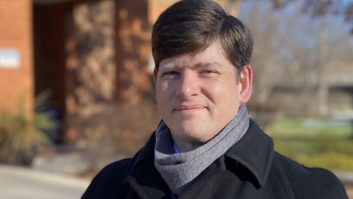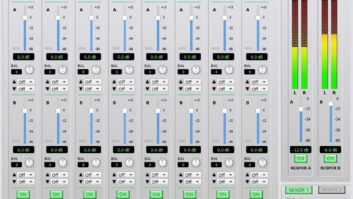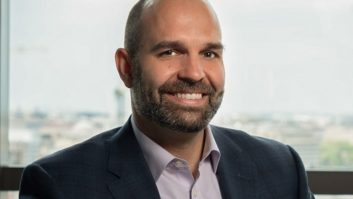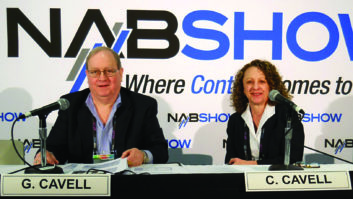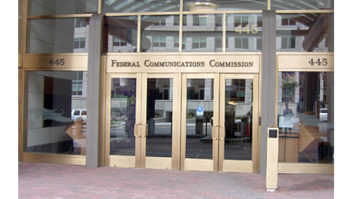A different kind of consolidation
Feb 1, 2007 12:00 PM, By Conrad Trautmann, CPBE
In July 2006, Westwood One moved into its newly renovated studio facility located in Culver City, CA. It took many months of planning and five months of execution to finish the project. Home to the nationally syndicated programs Loveline and The Tom Leykis Show, there was a lot we wanted to accomplish that we were lacking in our old facility. A router-based console system was a must. We also wanted auxiliary power so California’s rolling blackouts wouldn’t roll our shows right off the air. And we wanted studios that sounded good and were versatile.

The project began with Westwood One owning four buildings in Culver City but only occupying three. The fourth had been occupied by CBS Radio’s KTWV until CBS consolidated all of its stations into the Wilshire Blvd. location in 2005. KTWV moved out and left a well designed, but used radio station building empty. This building was across the street from Westwood One’s two buildings that housed the administration and sales offices and Metro Traffic’s studios.
About a mile away from the neat little annex of buildings were the radio network’s studios and operations. Inconveniently located and worn around the edges, it was time to update the 26-year-old building and equipment. It seemed to make sense to everyone to move the studios closer to the rest of the operation and renovate the former KTWV building to meet the network’s needs. Then, we could manage a clean transition rather than trying to renovate an existing space while people were trying to work in it.
Getting started
It was a pleasure to renovate a building that was designed as a radio station in its previous incarnation. Studios were already built with sound walls and doors, an auxiliary generator and UPS were already in place and a rack room existed with wire trays to the studios. Design was easy; we simply changed the floor plan by removing a few offices and adding a new main control room and studio. Everything else was reused: the offices, kitchen, bathrooms and existing studios.
Most of the renovation budget was spent updating the old infrastructure. New mechanical controls were needed for the air conditioning system because most of them no longer worked. New air conditioners were added for additional cooling. New fixtures in the bathrooms were installed as well as new carpet and paint throughout the space. The local building department required upgrades to the fire alarm system and we needed to add fire doors and renovate egress paths out of the building.
The rest of our budget was allocated for new studio furniture and equipment. We started by updating the inventory of equipment in our old building and then developed a wish list of what we wanted in the new building. If anything from the old building could be re-used, we removed that from the wish list. What was left was a long list of new items that we needed to purchase, because not much could be moved. We broke our list into three categories: furniture, broadcast equipment and console/routers. We sent our needs in each category to the appropriate vendors and built our budget from there.
Deciding on the console and routing system was a challenge. The available products have matured to the point where there are a lot of good choices with virtually unlimited flexibility. Pricing was competitive. We spent a lot of time talking to other customers and checking references. We looked for a track record of solid support from the vendor, as well as system reliability and up-time. And we looked at features to ensure the product could do the work. Any complex system will have expected bugs and problems that need to be ironed out by fine tuning configurations and using the correct hardware. What’s important is the follow-through from the manufacturer to help get those bugs worked out after the initial installation.
After all of our research, we still had three vendors to choose from. We selected Sierra Automated Systems (SAS) over the others for a few reasons. First was SAS’ proximity to our offices. With its factory in Burbank and our offices in the Los Angeles area, we knew getting parts and support would be easy. Secondly, we already had a 32KD router at the Metro Networks office across the street. With a fiber run through a conduit running between the buildings, it would be easy to tie the two routers together and share sources and studios. With that one fiber run, we essentially could double our studio capacity. And finally, our history of reliability, up time and support with SAS has been outstanding. We’ve used its routers at our larger Metro Networks offices throughout the United States for many years.
A different kind of consolidation
Feb 1, 2007 12:00 PM, By Conrad Trautmann, CPBE
Setting a foundation
After that decision, we focused on furniture. Omnirax was selected for two main reasons. The most important factor to us was customer service. David Holland, Omnirax’s lead salesperson, was on top of every detail. He worked with our architect and traded CAD drawings of the furniture to make sure everything would fit together. The other reason was that Omnirax was price competitive for a custom-designed system. Getting great customer service at a competitive price was a win-win.
Broadcast equipment was the final piece of the puzzle, and a lot easier to decide than the router and furniture. We bought new Zephyr Xstreams for ISDN and 360 Systems to replace some older units, and we repurposed our Enco Olympics equipment to use for sound effects, production beds and on-air spot delivery for our talk shows.
Audio editing is a primary function of the facility when it’s not on the air for a live show. Shows that we compile and edit in Culver City include Off the Record, In Concert, Out of Order, Beatles Brunch and Beatle Years and more. We started with all new Dell computers. We upgraded the CD-ROM drives to Plextor models because we’ve had better results with those writing masters than stock CD drives. We added a lot of hard drive space, upgraded the audio cards and purchased the latest version of Wavelab 6. Wavelab 6 has been the editing software of choice at the facility; everyone was used to it and it does the job. So rather than force Pro Tools or Adobe Audition on the staff, we simply upgraded what they already felt comfortable with, which has worked well.
With all the decisions made on the equipment, space plan and renovation, we received approval for our budget and then began the next phase of the project. Equipment lists were finalized and equipment was ordered at the beginning of April 2006. Our first construction meeting was at the end of April, where the demolition plans were confirmed with our general contractor. We had to coordinate carefully with the contractor a good time for an engineering crew to be on site to cable the space. We needed a time near the end of the demolition but before construction got too far along. That time was about the beginning of June. We sent in our team of company engineers to install all new home runs of Cat 5e cable and audio cables. The number of audio cables was significantly reduced from previous station builds we’ve completed with the selection of the SAS router-based system. Because the interconnects between the studios and the main router use Cat 5e, there’s hardly any need to put audio on a dedicated pair. Our team also pulled all new cable for the phones, computers and building alarm systems as well.
The cable runs and certifications of all the computer cables were completed by the end of July, which timed well with the town signing off on our electrical contractor’s work.
Our second crew of engineers arrived at the beginning of July. Their job was to assemble the furniture in the studios, install the router, consoles and all of the ancillary equipment, and then test it. We purchased, as part of our package with SAS, support time to configure each studio and the router. While we mimic many of the functions of a radio studio, we also have many unique tasks for the network that a radio station normally wouldn’t have. In a radio station installation, for instance, it’s common for all sources in and out to be stereo and the program feeds to be stereo. At the network, we have many mono distribution feeds so we need to be able to send and receive mono feeds to T-1s, ISDNs and other links.
A graceful move
An advantage of moving a network facility is that typically the studios are not in use 24/7 like a radio station air studio. This provided flexibility when deciding the transition date. We began by moving a few of the production studios during the last week of July. Then we picked a weekend to move the main talk studios.
The link between California and our main uplink and network operations center in New York is handled with Harris/Intraplex T-1 equipment. We took the opportunity to move our main program feed to a linear path, which has significantly improved the sound quality of our live broadcasts by reducing transcoding effects of multiple audio compression paths. We have a linear path in both directions, which has also helped with voice-overs and interviews conducted on both coasts. We also added a DS64-NC card with an Ethernet adapter that allows our Enco networks to trade files in both directions.
Once everyone was moved and all of the bugs were worked out, we hosted a visit by Genelec. We purchased 8030A self-power speakers for our studios and in the larger control rooms we added a 7050B subwoofer. Liveliness and frequency response was measured and adjusted by the Genelec representative. We were happy to find that the studios have flat response and behave well. After all, audio is our business and we wanted to know that we were starting off with the best product we can for our affiliate stations. The other advantage of stepping through this exercise is that we balanced all of the rooms so that they are as close as they possibly can be to each other. If you’ve ever worked in a radio station where there are different brands or even different models of speakers, the producers and talent always seem to have a favorite room. People will line up and wait for the favorite room to be free rather than use the empty room with the �bad� speakers. We did our best to make all of our rooms as equal as possible.
Westwood One’s Los Angeles operation is now positioned for the future. We have flexible routing, we have room to grow and we can accommodate anything we can think of today.
Equipment list
360 Systems Instant Replay
ADC punch blocks
Aphex 230 mic tube preamp
Dell PCs
Denon DN-C635
Enco DAD 32
ESE master clock system, GPS sync
Genelec 8030A, 7050B
Harris Intraplex T-1 equipment
Middle Atlantic racks O.C. White mic arms
Omnirax furniture
OMT Imedialogger
Rane HC6
SAS 32KD, Riolink, Rubicon
Shure SM7B
Tascam 102MkIII
Telos Zephyr Xstream, Delta 100
Whirlwind Headphone interface box
Trautmann is senior VP of engineering and technology, Westwood One, New York.
Online Extra
More photos and a floorplan of the Culver City facility are posted with this article online at beradio.com.
A different kind of consolidation
Feb 1, 2007 12:00 PM, By Conrad Trautmann, CPBE
The overall floor plan of the Westwood One Culver City facility
The computer monitors include call screening, Internet and producer/host communication.
Control Room 1 for the producer and board op.
Control Room 2 can be used as a back-up for CR1.
Control Rooms 3, 4 and 5 are primarily used for editing. Rooms 3 and 4 share a common voice booth for recording voice tracks, too.
A look at master control with Cat-5 connects, SAS router, OMT logger, GPS lock and NAS drives for network audio storage. �
A different kind of consolidation
Feb 1, 2007 12:00 PM, By Conrad Trautmann, CPBE
One of the announce booths.
Control Room 4, which has a similar look and feel to the other control roomsThe ADC Icon blocks carry all the cross connects.
The host position in Studio 1.
Control Room 2.
Another view from the rack room.





